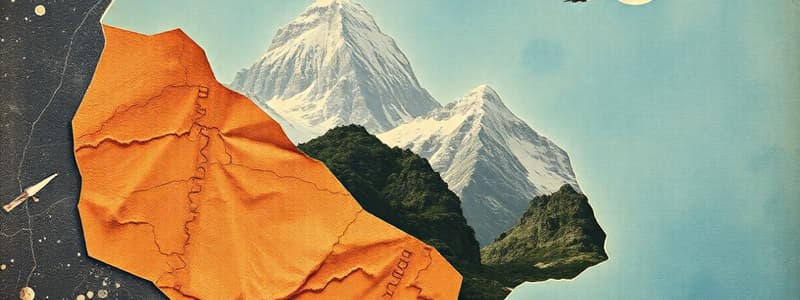Podcast
Questions and Answers
What is the term for the exact position of a place on Earth, typically given in coordinates?
What is the term for the exact position of a place on Earth, typically given in coordinates?
- Longitude
- Hemisphere
- Relative Location
- Absolute Location (correct)
Which of the following describes the movement of Earth's continents over millions of years?
Which of the following describes the movement of Earth's continents over millions of years?
- Seafloor spreading
- Continental drift (correct)
- Oceanic convergence
- Plate tectonics
What primarily constitutes the hydrosphere of the Earth?
What primarily constitutes the hydrosphere of the Earth?
- Living organisms
- Water in all its forms (correct)
- Landforms and rocks
- Gases in the atmosphere
Which term refers to the layer of gases surrounding the Earth?
Which term refers to the layer of gases surrounding the Earth?
The Richter Scale is used to measure what specific aspect of an earthquake?
The Richter Scale is used to measure what specific aspect of an earthquake?
Which line is used as the reference point for measuring longitude?
Which line is used as the reference point for measuring longitude?
What is the primary cause of tsunamis?
What is the primary cause of tsunamis?
Latitude lines run in which orientation around the Earth?
Latitude lines run in which orientation around the Earth?
Flashcards
Absolute Location
Absolute Location
The exact position of a place on Earth, typically given in coordinates of latitude and longitude.
Relative Location
Relative Location
The position of a place in relation to another place, often described using directions.
Hemisphere
Hemisphere
One-half of the Earth, typically divided into the Northern and Southern Hemispheres by the Equator, or the Eastern and Western Hemispheres by the Prime Meridian.
Latitude
Latitude
Signup and view all the flashcards
Longitude
Longitude
Signup and view all the flashcards
Hydrosphere
Hydrosphere
Signup and view all the flashcards
Lithosphere
Lithosphere
Signup and view all the flashcards
Atmosphere
Atmosphere
Signup and view all the flashcards
Study Notes
Chapter 1
- Geography: The study of Earth's physical features, climate, human populations, and interactions.
- Absolute Location: Precise position on Earth, given by latitude and longitude coordinates.
- Relative Location: Position of a place in relation to another place, often described by directions.
- Hemispheres: Earth divided into halves (Northern/Southern, Eastern/Western) by the Equator and Prime Meridian.
- Latitude: Imaginary lines running horizontally around Earth, parallel to the Equator.
- Longitude: Imaginary lines running vertically from the North Pole to the South Pole.
- Equator: Imaginary line around Earth's middle, equidistant from the poles.
- Prime Meridian: Imaginary line running from the North Pole to the South Pole.
Chapter 2
- Hydrosphere: Water on Earth (oceans, rivers, lakes, glaciers, groundwater, water vapor). Covers 71% of Earth's surface.
- Lithosphere: Earth's crust and upper mantle, divided into tectonic plates that float on the semi-fluid asthenosphere.
- Atmosphere: Layer of gases surrounding Earth, including all living organisms and their interactions.
- Biosphere: Zone of life on Earth, encompassing all living organisms and their interactions with other spheres.
- Continental Drift: Theory that Earth's continents were once joined (Pangaea) and have drifted apart due to tectonic plate movement. Proposed by Alfred Wegener in the early 20th century.
- Earthquake: Sudden, violent shaking of Earth's surface, caused by energy release from tectonic plate movement or volcanic activity.
- Richter Scale: Measures earthquake magnitude based on seismic wave amplitude.
- Tsunami: Series of large ocean waves caused by sudden displacement of water (e.g., undersea earthquake, volcanic eruption, landslide).
Studying That Suits You
Use AI to generate personalized quizzes and flashcards to suit your learning preferences.




